Oregon Wine Visits, June 2023 – Part 2
It was now about midway through my week-long road trip to visit my friends Jon & Ling at their home in the Portland area, and I’d only stopped at one winery! Seeing my friends was the main reason for the trip, and I knew beforehand that I’d only be able to squeeze in a few wine visits along the way while I was in Oregon wine country.
Neither Jon nor Ling are big wine drinkers but they wanted to spend a day wine tasting with me, so we headed out on a sunny Sunday morning to Willamette Valley. We’d agreed on a tasting room to visit there that morning, located in Carlton.
Ken Wright Cellars
My friends Jon & Ling and I rolled into the town of Carlton and it was easy to spot our next destination, the tasting room of Ken Wright Cellars, as it’s located on a prominent corner of the main street through town. In 2003, Ken Wright and his wife Karen purchased the building, an old train station that dates from 1923, and after two years of renovation they opened it as the winery tasting room. We were welcomed in by tasting room service manager Sydney Beck, and since the weather was so pleasant that morning we decided to taste outside on the large covered patio. We sat at a large round table, and Sydney brought out lots of information about the winery as well as on the specific wines that we would be tasting.
Ken Wright has been making wine in Willamette Valley for nearly 40 years, but it took him some time before he first came there. He grew up in Kentucky and first developed an appreciation for fine wine when he worked in a restaurant in Lexington. He decided to move to California, where he studied viticulture and enology at UC Davis. Ken started out in the wine business in 1978, working in Monterey County at Ventana and then at Chalone with vintner Dick Graff. While he was at Chalone, he had the opportunity to participate in a group that Graff started called the Small Winery Technical Society, which brought him into contact with a number of other noted winemakers, including Steve Kistler of Kistler, Josh Jensen of Calera, and Richard Sanford and Bruno D’Alfonso of Sanford. In 1982 Ken helped develop vineyards and a winery for a new producer in Carmel Valley, Talbott Vineyards.
By 1986 Ken was ready to strike out on his own, and having seen the potential for top-quality Pinot Noir in Willamette Valley, he moved there with his family. That same year, his first wine venture there was co-founding Panther Creek Cellars. He sold Panther Creek in 1994 and then established his own Ken Wright Cellars label with Karen. The winery’s focus from the start has been on single-vineyard Pinot Noir from top vineyards in Willamette Valley. In 2001, they launched a sister label called Tyrus Evan – named for Ken’s sons Cody Tyrus and Carson Evan – for wines made from non-Willamette Valley fruit sources. The Ken Wright winery was built in 1999, and wines are now made there, near the tasting room in Carlton.
 |
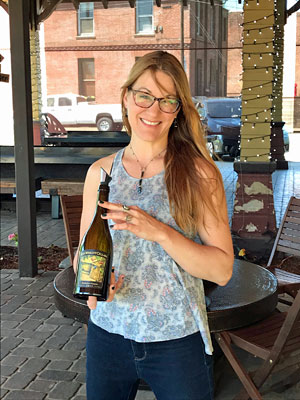 |
From the beginning of his time in Oregon, Ken looked to improve the process of making Pinot Noir. He’s said to have been the first in Willamette Valley to introduce a sorting line at the winery, first to use dry ice to keep fruit cool prior to the start of fermentation, and first to buy fruit by the acre rather than by the ton. Ken was also one of a group of vintners who worked to petition the Federal Government to create six AVAs within the larger Willamette Valley wine region – Yamhill-Carlton, Chehalem Mountains, Ribbon Ridge, Dundee Hills, McMinnville, and Eola-Amity Hills. These six AVAs were approved around 2006, and other “sub-AVAs” within Willamette Valley have been added since then.
A key distinction in the wine from different vineyard sources goes back to the soil and underlying rock that the vines are planted in. Most soil and rock in the northern Willamette Valley (where all of the vineyards for Ken’s wines are located) falls into two basic types – volcanic or sedimentary. Dundee Hills and Eola-Amity Hills feature predominantly volcanic clay soil, which Ken feels gives the Pinot Noirs from those areas a more fruit-driven profile, while Yamhill-Carlton and Ribbon Ridge have more sandy marine sediment soil, leading to more spice and savory character in the wines. Of course there are finer distinctions within these broad profiles, but these two basic categories are important for understanding the Pinots from various parts of Willamette Valley.
Ken Wright was one of the earlier vintners to designate Pinot Noirs as single-vineyard wines in Willamette Valley, and he currently makes 12 single-vineyard Pinot Noirs. These include a number of wines from the Yamhill-Carlton AVA, plus some from Ribbon Ridge, Dundee Hills, and Eola-Amity Hills (Ken and Karen own both Canary Hill Vineyard and Carter Vineyard there), and a couple from the broader Willamette Valley AVA. The winery also produces a few appellation Pinot Noirs that blend fruit from multiple vineyard sources. A number of the vineyards that Ken sources fruit from are certified organic, and he works to ensure that all the sites maintain soil and vine health through promoting microbial activity in the soil.
The winemaking for all of Ken’s single-vineyard Pinot Noirs is essentially the same, allowing the vineyard source to be showcased above any particular winemaking style. Fruit from each vineyard is separated by clone, sorted, and then fermented in small open-top vessels until the wine is pressed at dryness into French oak barrels. Typically about 20% of the barrels are new, and the wine is aged for 10-11 months before being racked to tank for bottling. Ken also makes a smaller amount of white wine. Both Chardonnay and Pinot Blanc are barrel-fermented on the lees, with Chardonnay in around 18% new French oak and Pinot Blanc entirely in older barrels.
At the tasting room in Carlton, Sydney brought out two wineglasses for us to compare a pair of appellation Pinot Noirs. The 2021 Eola-Amity Hills Pinot Noir and 2021 Yamhill-Carlton Pinot Noir gave us a perfect opportunity to taste the difference between wines from these two AVAs and the effect of volcanic vs. sedimentary soil on the wines. The Eola-Amity Hills bottling featured earthy black cherry fruit aromas with tea leaf and a touch of spice, medium-light body with bright acidity, and a long, tangy finish – it developed with some air and gained a stony mineral note. The Yamhill-Carlton Pinot had tart cherry fruit, floral notes, plus earth and spice undertones, with a bit more texture on the palate and finish.
 |
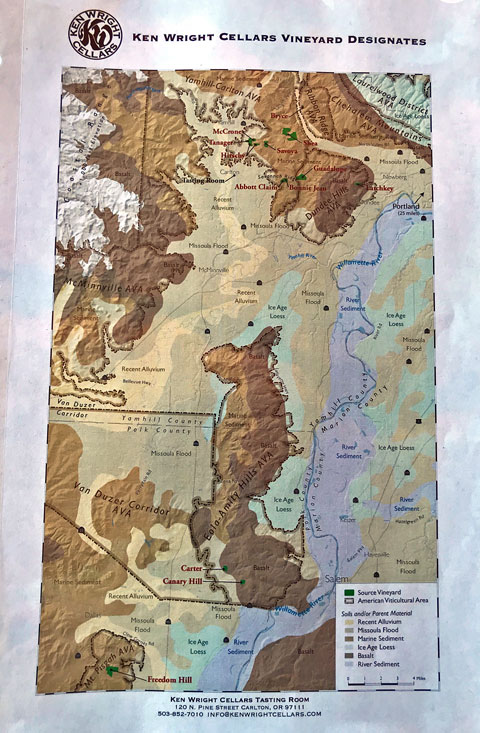 |
| (click to expand map of vineyard designates) |
We followed that interesting comparison with three single-vineyard Pinots, all from the Yamhill-Carlton AVA. First was the 2021 Bonnie Jean Vineyard Pinot Noir. This displayed more focused spicy and floral black cherry fruit with earth, tea leaf, and oak in support, medium weight with a bit more structure than the two appellation wines and a long, lively finish. Next was the 2021 Hirschy Vineyard Pinot Noir, which had riper and more intense cherry aromas than the previous wine with floral, spice, and stony mineral notes plus a touch of oak, a richer mouthfeel and more grip on the finish. Our final Pinot was the 2021 Tanager Vineyard Pinot Noir, from a site very close to Hirschy. It featured bright and focused red fruits, spice, tea leaf, and earth, with less apparent oak on the nose, medium body with a silky texture and lively acidity, and fine tannins on the long finish.
Sydney brought out one wine for us to taste that wasn’t on the regular tasting list. The Tyrus Evan 2021 Red Blend is a blend of 45% Cabernet Sauvignon, 30% Merlot, 15% Malbec, and 10% Petit Verdot, sourced from six vineyards in Columbia Valley to the east of Portland. This was a lighter-weight Bordeaux-style blend, with ripe plummy fruit, dried herbs, and spice, a medium-rich mouthfeel, and good structure – while it’s certainly approachable now, a few years of cellaring should help smooth out the moderately grippy finish.
In addition to the wines we tasted, Ken Wright makes other appellation and single-vineyard Pinot Noir bottlings, including wine club-only single-clone bottlings. They also make bottlings of Chardonnay, Pinot Blanc, and Pinot Noir Rosé. Each of the single-vineyard Pinots features different label artwork by local artist David Berkvam.
Sydney did a fine job of guiding Jon, Ling, and me through the current tasting lineup of Ken Wright Cellars – she was very knowledgeable and personable. This was my first Willamette Valley tasting in many years and Sydney was great at helping to re-introduce me to the distinctions between its many subregions and their wines. I really enjoyed the atmosphere of the tasting room patio too – even though it’s right off the main route through town, it seemed serene and relaxing. The 2021 Yamhill-Carlton Pinot Noir, 2021 Bonnie Jean Vineyard Pinot Noir, and 2021 Tanager Vineyard Pinot Noir were my favorites of the tasting, with the Tanager Vineyard bottling being a particular highlight for me. Even though I prefer to make appointments for winery visits, it’s great when dropping in at a tasting room offers as enjoyable an experience as my friends and I had at Ken Wright. It’s certainly worth a visit there if you’re wine tasting in the Carlton area.
Jon, Ling, and I hadn’t made any lunch plans for that Sunday, so as we were finishing up our tasting at the Ken Wright tasting room Jon checked on his phone for lunch spots nearby. One that looked good was just on the next block along the main street of Carlton. We stepped into The Horse Radish café and the place was packed – always a good sign at a restaurant – but we managed to snag the last available table. I felt like having something on the lighter side so I had a very tasty ham and potato frittata with a side salad. Jon & Ling enjoyed their dishes too, and I wouldn’t hesitate to return there if I’m looking for lunch in the Carlton area during a future visit.
We drove back toward Portland after lunch, and I thought we might be able to stop in at the other winery I had in mind for a visit that day. I recalled seeing that it was open by appointment only, and although I’d emailed them but hadn’t gotten a definite response, I figured it was still worth a try. Fortunately for us, things worked out and we were able to stop in for tasting and I was glad that we could – it featured one of the more interesting wine lineups I’ve run across in awhile.
Teutonic Wine Company
The small urban winery of Teutonic Wine Company is located in southeast Portland, a short distance across the Willamette River from Interstate 5. My friends and I arrived there around mid-afternoon and stepped inside of the small tasting room. Tasting room manager Leslie Kossoff greeted us, and I mentioned that I’d emailed a request to visit there. She told us that she could accommodate us and asked if we could wait for a couple of people who were also coming in so we could coordinate the tastings. My friends Jon & Ling are not as familiar with wineries as I am, and they asked Leslie if they could take a quick look at the rest of the facility. It’s a pretty typical urban winery, with barrel stacks, stacks of half-ton fermentation bins waiting for this year’s crush season, destemmer, press, other winery equipment, and assorted odds and ends, all squeezed into a compact space. We returned to the tasting area, where the other people had arrived, and Leslie started us off on our tasting, telling us about each wine as well as about the background of the winery as we proceeded.
Teutonic gets its name from the inspiration behind the wines, the Mosel Valley in Germany and Alsace wine region of eastern France. The idea for Teutonic goes back to 2002, when Barnaby Tuttle was the general manager and wine buyer for Papa Hadyn restaurant in Portland, and a German wine importer brought in 14 Rieslings from the Middle Mosel for him to taste. Barnaby was impressed with how different they tasted from one another despite being from the same wine region, and how the vineyard soil influenced these differences. He not only bought all 14 Rieslings for the restaurant wine list but resolved to learn how to make wines that expressed their terroir as well as those German wines did.
In 2005, Barnaby and his wife Olga learned that a friend had a farm property that they weren’t using, and they asked if they could plant a vineyard there. The friend told them yes, and they jumped on the opportunity! Located in Alsea, it’s southwest of Portland, about 20 miles from the ocean and at an elevation of around 1,250 feet. Though the Tuttles had no vineyard experience up until that time, they learned on the fly on a shoestring budget, helping to plant and farm a two-acre vineyard, mostly with Pinot Noir along with some Pinot Meunier and Pinot Blanc. For the next few years, Barnaby experimented at making small quantities of wine until in 2008 he finally decided to leave the restaurant business and work in the cellar at Laurel Ridge Winery in Willamette Valley. By that time, the Alsea Vineyard had their first crop and Barnaby and Olga made a few barrels of wine. Realizing that they had too much for just friends and family and that they needed to sell the wine, they launched the Teutonic label.
Since then, Barnaby and Olga have increased their wine production to around 5,000 cases per year, and they work with a number of different varieties from various vineyard sources in Willamette Valley and beyond. They insist on sourcing fruit from sustainable (organically-farmed though not necessarily certified organic) dry-farmed vineyards on cooler higher-elevation sites, and ideally with older vines. Winemaking is low-intervention, with native yeast fermentations in small fermentation vessels and aging entirely in neutral oak barrels. This explains the motto printed on the back label of the Teutonic wines – “Old & Cold, High & Dry, Wood & Wild.”
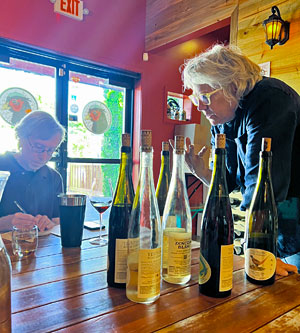 |
| (photo above, taken by Ling Fong) |
 |
Leslie told us that the 2022 white wines had been bottled fairly recently, and that most of the 2022 reds will be bottled before this year’s harvest and crush. The white varieties are fermented and aged in older barrels, to provide more texture to the finished wines than stainless steel tanks would do. Reds are fermented in half-ton macrobins. As we would hear during our tasting with Leslie, Barnaby loves to use some winemaking techniques that more “conventional” vintners often shy away from. These include fermenting white grapes on their skins, fermenting in clay amphorae, using a “pied de cuve” technique for maintaining a supply of native yeast for fermentations during a harvest season, and sharing flor yeast (a yeast that sometimes develops on the surface of wine in a barrel) from one barrel to another. And then there are the interesting wines that Barnaby comes up with. A White Tannat? A Gewürztraminer-Pinot Noir blend? Sure, why not!
One area where Teutonic differs from many other low-intervention wineries is that they filter some of their wines for stability because they have a little residual sugar. Barnaby looked to the practice in a number of German and Alsatian Rieslings of retaining a bit of residual sugar in the wine to help balance out the high natural acidity of the grapes. The level of residual sugar that Barnaby leaves in the wines varies according to their acidity. I tasted wines that Leslie told me had a touch of residual sugar, and I didn’t perceive them as being sweet since the acidity balanced the sugar so well. In general, the Teutonic wines are higher in acidity and lower in alcohol than many, and Barnaby’s restaurant background led him to understand that higher-acid wines tend to go better with food. A number of top restaurants throughout the country carry Teutonic wines on their lists.
The first wine Leslie poured was the 2022 “Cutthroat Trout Blanc”. This was sourced from vineyards in both Oregon and Washington, and consists of co-fermented Chardonnay and Pinot Noir – since the Pinot fruit is pressed immediately, it adds virtually no color to the wine. This had bright apple and pear aromas with floral undertones, medium weight on the palate with a lively texture and finish. Next was the 2022 Crow Valley Vineyard “Candied Mushroom” Riesling – this came from a site near Eugene in southern Willamette Valley where Teutonic also gets Pinot Gris, Gewürztraminer, and Pinot Noir. It’s highly unusual for a dry table wine in that it’s made from fruit where botrytis mold has formed – such fruit is typically made into very sweet dessert wines. Leslie told us that they macerate the fruit for 4-5 days on the skins before pressing and then ferment it dry in neutral oak – she said they call it their “umami tsunami”! It was certainly distinctive – not fruit-forward but with herbal, earth, and forest floor aromas that were supported by pear and stone fruit notes along with a touch of petrol, and perhaps a hint of honey character from the botrytis but without the sweetness. The wine was medium-bodied with vibrant acidity and a long finish.
We followed up with the 2022 Borgo Pass Vineyard “Borgo Vin Gris”, from a small Willamette Valley vineyard near Corvallis that was one of Teutonic’s earliest fruit sources. The wine is from co-fermented Pinot Gris and a little Pinot Noir. It displayed strawberry aromas plus stone fruit and flowers, a bright mouthfeel and lively finish. Leslie next poured the 2022 “Zenczak Blanc” – it’s a White Pinot Noir, pressed off the skins right away so there’s very little color in the wine. This also had strawberry notes but with earth and mushroom undertones and a bit more textured mouthfeel. A similar winemaking method was used for the 2022 “Bacalao” White Tannat. Barnaby & Olga loved Tannat from the Basque region and searched for fruit to make some, but it’s been difficult to find any in Oregon – the fruit for this wine came from Yolo County in California, and this is Teutonic’s first White Tannat since 2015. Making a white wine from a red grape as tannic as Tannat is quite a feat! This one featured bright peach and stone fruit aromas with a distinct floral element, with more structure on the palate than the previous wine and a bit of grip on the finish.
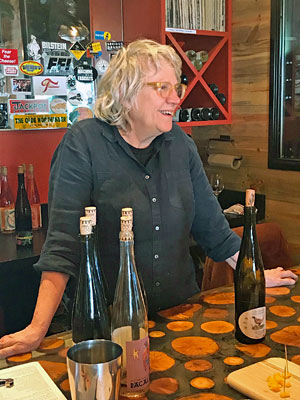 |
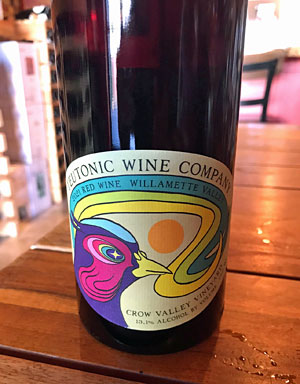 |
Leslie moved us on to red wines, although the first one that she poured was actually co-fermented 75% Gewürztraminer and 25% Pinot Noir – the 2021 Crow Valley Vineyard Red Wine. Teutonic has been making this fascinating co-ferment for over 10 years. Leslie told us that it tends to be a polarizing wine, but I was a fan! The first aromatic impression was predominately the Gewürztraminer component, with lychee and flowers, but that was then joined by the bright cherry notes of the Pinot component, with juicy acidity in the mouth and a long, crisp finish. Next was the 2021 Borgo Pass Vineyard Pinot Meunier, sourced from 25+ year-old vines at the vineyard. The character was similar to Pinot Noir, with black cherry notes and lots of earth and forest floor on the nose, with vibrant acidity and a long and slightly tangy finish.
We tasted two Pinot Noirs, beginning with their entry-level 2021 Willamette Valley Pinot Noir. With bright red cherry and earth aromas, medium-light body, and a lively finish with mild tannins, this would be perfect for near-term drinking. The 2015 Alsea Vineyard Pinot Noir followed this, sourced from the vineyard that Barnaby helped establish in 2005. A more serious and complex Pinot than the previous one, this displayed strawberry, earth and forest floor, fresh herbs, and a touch of spice on the nose. Nice texture on the palate, with the acid and tannin structure to help this develop further in the cellar.
Two bigger red wines concluded our tasting at Teutonic. The 2021 “Recorded in Stereo” Syrah was sourced mostly from Eastern Oregon, and blended with a little Pinot Meunier, Pinot Noir, and Chardonnay from a few tiny backyard vineyards, including from Barnaby’s own. The wine is made to honor jazz drummer Alan Jones, and $1 per bottle goes to his Alan Jones Academy of Music. Barnaby is a jazz fan, and the “Recorded in Stereo” Syrah is not the only Teutonic wine that’s featured a jazz theme on its label. Prior to the pandemic, the winery had been the venue for regular jazz performances as well. Lighter color, the wine featured bright and somewhat higher-toned red fruit aromas plus spicy and savory notes, medium body, and loads of acidity on the lively finish. The final wine of our tasting was the 2021 “Bacalao” Tannat. This had earthy and slightly smoky dark berry fruit with herbal undertones, a big and rich mouthfeel with plenty of structure and a finish that was grippy but not harsh.
Teutonic produces a large number of bottlings, and the lineup can change from year to year. Recent wines include Silvaner, Traminer, Gewürztraminer, several additional Riesling bottlings including “Raspberry Mushroom Riesling” (Riesling pressed through Pinot Noir grape skins), Grüner Veltliner, Pinot Gris, Pinot Blanc, Chasselas, Muscat, Viognier, other Rosé and Vin Gris bottlings, additional Pinot Noir bottlings, additional white and red blends, and the occasional sparkling wine. Many of the bottlings feature new label designs that have been introduced in recent years. I asked Leslie about the pheasant theme on some of the wine labels, and she told me that this stems from Barnaby’s feeling that these wines go well with wild game. Teutonic is open for tasting by appointment.
Though I’d known about Teutonic Wine Company for a number of years, I’m not sure I’d ever actually tasted their wines before my visit there, and my friends and I all had a great time there. Leslie went out of her way to accommodate us and she was exceptionally affable, doing a fine and entertaining job of telling us about the vineyards, winemaking, and wines. Some tastings with as many wines as we tried at Teutonic can feel rushed, but the relaxed pace with which Leslie led us through them seemed perfect to me. I thought that the tasting room itself reflected the Teutonic wines in many ways – imaginative, maybe a little unconventional, and ultimately very enjoyable. I particularly liked the 2022 “Candied Mushroom” Riesling, 2022 “Borgo Vin Gris”, 2022 “Bacalao” White Tannat, 2021 Crow Valley Vineyard Red Wine, 2021 Pinot Meunier, and 2015 Alsea Vineyard Pinot Noir – the Riesling was my overall favorite but a couple of the others weren’t far behind. I always like to keep an eye out for interesting urban wineries, and you won’t find many with wines as distinctive as those at Teutonic – highly recommended.
From the Teutonic tasting room it wasn’t too long a drive back to my friends Jon & Ling’s house in Camas after our pleasant day of wine tasting. The next morning was Monday – Jon & Ling both needed to get back to their jobs and it was time for me to start on my way back home, though I would be taking the longer and more scenic route back to the Bay Area.
|












